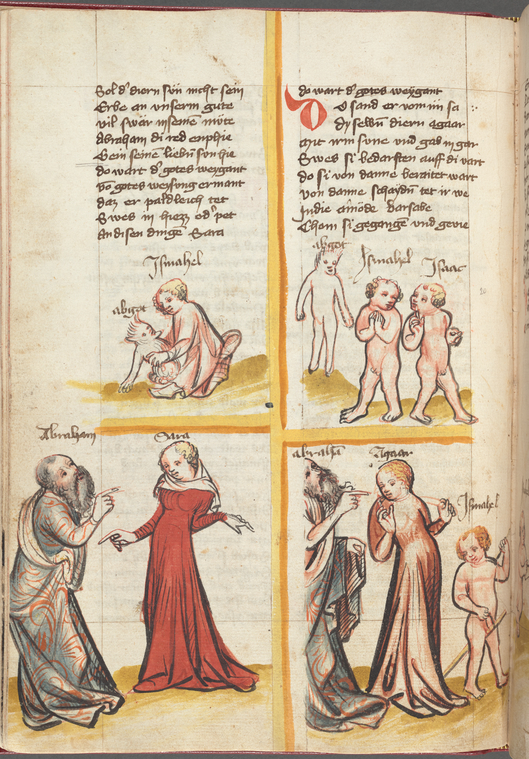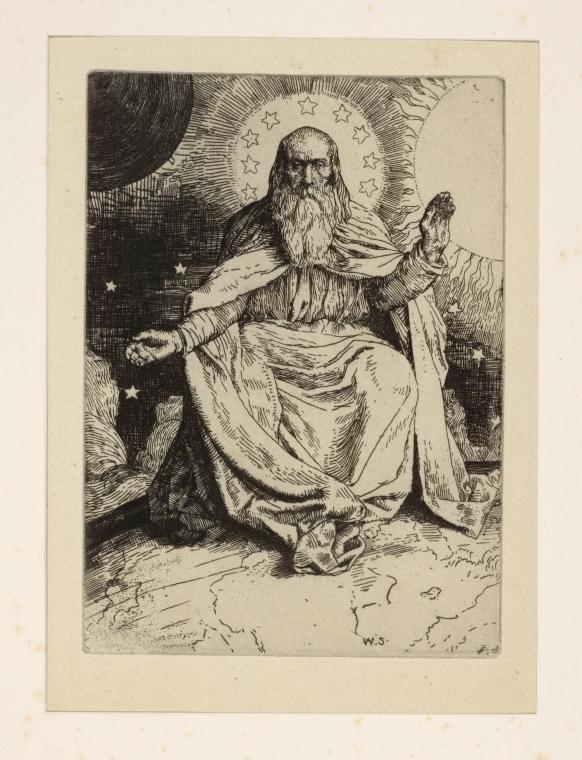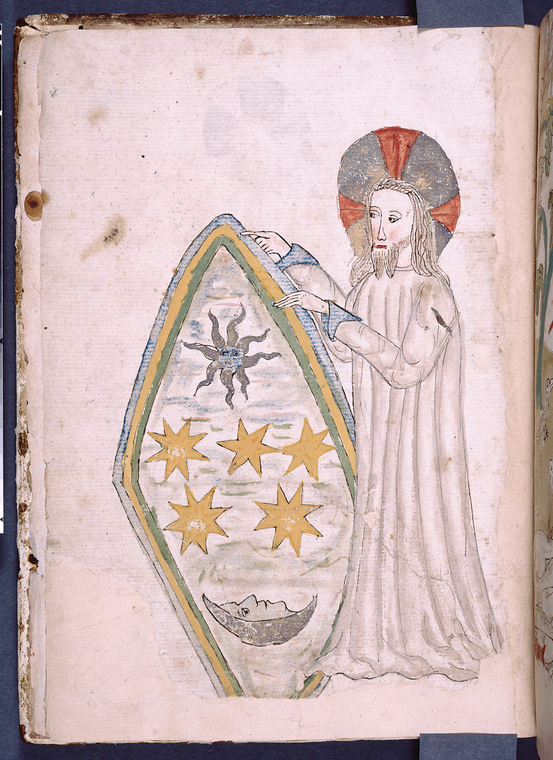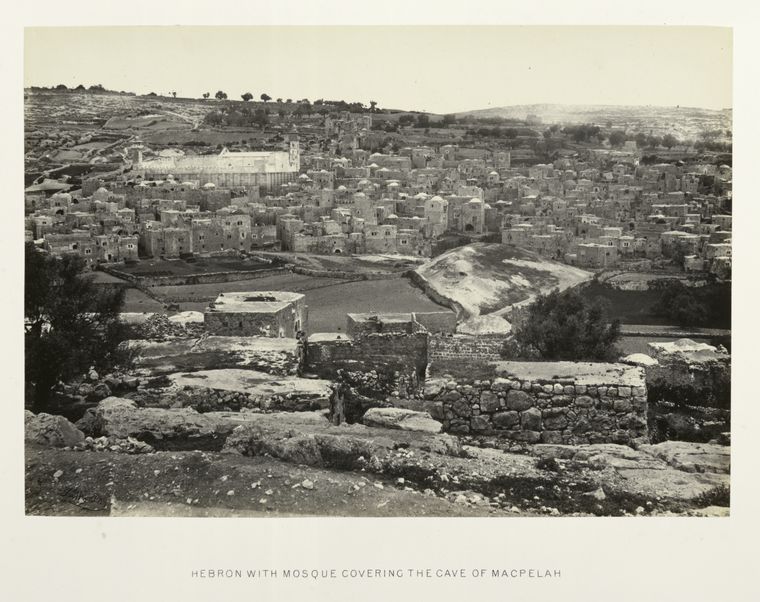Three Faiths
On the Shadows in Abraham's Cave: Thoughts on Beryl Korot and Steve Reich's 'The Cave'
 The Cave, by wife and husband team Beryl Korot (video artist) and Steve Reich (composer), is an experimental multimedia piece featuring recorded interviews set to live music. Palestinians, Israelis, and Americans are all asked about the significance of the story of Abraham and his burial place, The Cave of Machpelah, which is held sacred by Muslims, Christians, and Jews.
The Cave, by wife and husband team Beryl Korot (video artist) and Steve Reich (composer), is an experimental multimedia piece featuring recorded interviews set to live music. Palestinians, Israelis, and Americans are all asked about the significance of the story of Abraham and his burial place, The Cave of Machpelah, which is held sacred by Muslims, Christians, and Jews.
Interviewees are asked about the significance of Abraham to their lives, the significance of his two sons Ishmael and Isaac, and their two mothers Hagar and Sarah. Adherents to the three traditions share many of the colorful details within their respective oral traditions and sacred texts; but also discuss their common roots, revealing an often-forgotten familial bond that exists through these roots. The performance then combines the spoken word, music, and video in a pastiche of perceptions, as the music reveals a natural tonality and rhythm to everyday speech. The details of Abraham's story found in these varied traditions are woven together to appear as merely different perspectives of the same story. What emerges is a moral lesson of sorts, but one that feels like its just naturally being learned through an honest examination of the world as it is.
The Moral: there is a shared reason the three faiths hold Abraham to be "our father". The Cave provides a sacred space, a gateway through which to find common ground; and that is what the piece invites us to discover. Further, the 'cave' encompasses even more than the monotheistic traditons. It is a well-known archetype, used by no mistake; so the Platos and Freuds among us can also join the conversation. For in Abraham's cave, too, there are shadows. Shadows that silently imply something much, much more.

* * * * *

 According to the Book of Genesis, at the time of Abraham the last time God and man had spoken was when God promised Noah He'd put a rainbow in the clouds..." An everlasting covenant between Me and you and every living creature on the earth" (Genesis 9) But that had been 300 years prior! Since then, God and humans had not conversed at all, at least not any conversation worth noting in Genesis.
According to the Book of Genesis, at the time of Abraham the last time God and man had spoken was when God promised Noah He'd put a rainbow in the clouds..." An everlasting covenant between Me and you and every living creature on the earth" (Genesis 9) But that had been 300 years prior! Since then, God and humans had not conversed at all, at least not any conversation worth noting in Genesis.

Enter Abraham, who I now understood as a "re-discoverer" of monotheism, if you will. Yes, between Noah and Abraham in the Genesis narrative, for 300 years, nobody is said to have offered so much as a simple prayer in the God of monotheism's general direction. This is the world Abraham is born in to. For the three faiths, Abraham distinguishes himself before God as righteous because he is given no blueprint for his belief in monotheism, no pious father to follow in the footsteps of, no temple save that which was made to glorify the greatness of earthly kings and false gods, nothing but his own power of reason which moves him toward faith in an unseen God.
 Here we must leave the at times laconic narrative of Genesis and pick up with the rich details of the Midrash of Judaism, and the Koran in Islam. These sources describe Abraham as quite literally an iconoclast (Greek for 'image-breaker'), rebelling against the idolotry of the time and philosophically finding his own way back to monotheism. His father, Terach, not only knew nothing of monotheism, but in fact made idols and sold them for a living. A young Abraham could not hold back his scepticism as he saw people praying for blessings to the idols his father had made. Upon being left in charge of idol-selling one day, he would ask his customers, "how old are you?" The reply being fifty, or sixty years. Abraham would say, "Isn't it pathetic that a man of sixty wants to bow down to a one-day-old idol?" The customers would feel ashamed and leave ( Midrash Bereishit 38:13).
Here we must leave the at times laconic narrative of Genesis and pick up with the rich details of the Midrash of Judaism, and the Koran in Islam. These sources describe Abraham as quite literally an iconoclast (Greek for 'image-breaker'), rebelling against the idolotry of the time and philosophically finding his own way back to monotheism. His father, Terach, not only knew nothing of monotheism, but in fact made idols and sold them for a living. A young Abraham could not hold back his scepticism as he saw people praying for blessings to the idols his father had made. Upon being left in charge of idol-selling one day, he would ask his customers, "how old are you?" The reply being fifty, or sixty years. Abraham would say, "Isn't it pathetic that a man of sixty wants to bow down to a one-day-old idol?" The customers would feel ashamed and leave ( Midrash Bereishit 38:13).
Abraham is asked by another customer to offer a sacrifice to the idols. He smashes all the idols, and puts a hammer in the hands of the biggest idol. When they discover the smashed idols, he says he went to offer one of them some bread, and all the idols came to life and started fighting. So the biggest one grabbed a hammer and smashed all the others. When the people say, "Are we to believe these statues now have minds!?..." He simply says, "listen to yourself! Yet you pray to them like gods!"

This is why God ('Allah' in the Koran; 'Yaweh' in the Torah) is said to have sanctioned the line of Abraham to be a great nation, through which "all the families of the earth shall be blessed." (Genesis 12:3) And as I understand it, this is why Judaisim, Christianity, and Islam all consider Abraham to be the father of monotheism.
Reich describes his own perception of the story:
Abraham is about as radical and visionary a person as we've ever had. He lived in a world where people saw the forces of nature as the highest value. The sun, the moon, the stars, trees, various statues - they worshiped these things. Abraham said, "None of the above." When Abraham breaks the idols in his father's idol factory, "He puts his life on the line by doing that and in both traditions is miraculously saved from the fiery furnace that King Nimrod throws him into. Here is a man who has a totally different conceptual take on the true focus for human worship - one that is unified, invisible and ultimately ethical. And that view ultimately prevails, and we are still living with that view.
* * * * *

"And there he sees shadows. He knows intuitively that they are the shadows of Adam and Eve, as he also senses something verdant and lush, and again he intuits: this is the Garden of Eden. At that moment he knows that this is the place where he and his family will be buried, and he takes the calf and returns to feed his guests. That story was magical to me because that simple act of fetching a calf to perform an act of hospitality for strangers connects Abraham with the prehistorical mother and father of all humanity." - Beryl Korot
Abraham's cave was explicitly chosen as a recognizeable archetype. The shadows Abraham observes represent that which is seen, but they are understood as evidence of that which is not seen. And what is not seen is greater, more real and more permanent, than what is seen. Abraham was born into a world of many different gods. For him, these gods were mere shadows that can appear or disappear completely at the mercy of their source. His re-establishing of monotheism was to remedy this perceived dilemma of religious devotion. According to Abraham's faith, God is the creator of heaven and earth; THE source; of which there can be only one. He is not made by another, or "caused" by another. Monotheists do themselves a disfavor if they continue to insist their God is different from the others. The three faiths all pray to the Creator of heaven and earth, they all believe there is only one such diety, therefore they must all be praying to the same God. According to the premise of monotheism, this must be the case.
* * * * *

"Isaac and Ishmael come together to bury Abraham. The traditional Jewish view is that Ishmael's and Isaac's presence at their father's burial was a sign of their reconciliation. And if they could do it, perhaps it suggests Arabs and Israelis can too. But it requires real generosity of spirit and a genuine willingness to accept difference." - Steve Reich
This cave is in the West Bank city of Hebron, a city not unaccustommed to political and religious turmoil. Through the centuries it has passed hands from faith to faith many times, and the site has been home in turn to Synagogues, Mosques, and Churches. It is now known as The Cave of The Patriarchs, and to this day the three faiths all consider it a sacred place. Yet, political division is still very much alive in the Mosque above the cave at Machpelah. Though it is one of only a few places where Jews and Muslims are both permitted to pray, the building is segregated. Muslims on one side, Jews on the other. In yet another part, tourists file through being told that according to legend Adam and Eve, the primordial mother and father of us all, are buried there.
On February 25, 1994, shortly after the piece The Cave debuted, a Jewish settler entered the Mosque atop the Cave and open-fired, killing 29 praying Muslims. The irony of this tragedy is that those Muslims were no doubt praying to the God of Abraham; the same professed God of the shooter. He had forgotten his own scripture, the Torah, when Yahweh explicitly blesses Ishmael, and through him the Arab people. His act was a blatant attempt to deny the reconciliation the Korot/Reich piece hoped to encourage. The couple, writing at the invitation of The New York Times shortly after the shooting, writes:
We do not think The Cave or any other artwork can directly affect peace in the Middle East...
The current cycle of political events leaves too little room to maneuver. Peace as a religious value is cast aside to settle old scores, and all citizens of this area are denied what they seek...Peace in this part of the world could create a great flowering of culture throughout the region, and offer something culturally distinct that we believe the West may have forfeited in its embrace of the secular as religion. But peace will never come at the expense of either Ishmael or Isaac - or in the absence of their memory.
- "Thoughts about the Madness in Abraham's Cave" -Steve Reich and Beryl Korot. New York Times, Sunday, March 13, 1994.
* * * * *
All quotes not specifically attributed to other sources come from the libretto to The Cave: conceived and developed by Steve Reich and Beryl Korot (music, Steve Reich; muti channel video and screen design, Beryl Korot).[London] : Hendon Music, a Boosey & Hawkes Co., c1993.
Explore the Library's exhibition, Three Faiths, on display October 22, 2010 - February 27, 2011 in the Stephen A. Schwarzman Building on 5th Avenue between 40th and 42nd streets.
NYPL CATALOG LINKS TO SOURCE MATERIAL:
The Cave on CD -Steve Reich/Beryl Korot.
The Cave Libretto (includes texts of interviewees, and interviews with Reich and Korot).
The Koran / translated with notes by N.J. Dawood.
Plato's Republic / translated from the new standard Greek text, with introduction, by C.D.C. Reeve.
SUGGESTED FURTHER READING:
The woman who named God : Abraham's dilemma and the birth of three faiths / Charlotte Gordon.
Read E-Books with SimplyE
 With your library card, it's easier than ever to choose from more than 300,000 e-books on SimplyE, The New York Public Library's free e-reader app. Gain access to digital resources for all ages, including e-books, audiobooks, databases, and more.
With your library card, it's easier than ever to choose from more than 300,000 e-books on SimplyE, The New York Public Library's free e-reader app. Gain access to digital resources for all ages, including e-books, audiobooks, databases, and more.
If you don’t have an NYPL library card, New York State residents can apply for a digital card online or through SimplyE (available on the App Store or Google Play).
Need more help? Read our guide to using SimplyE.